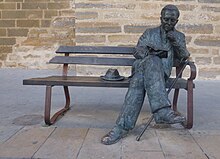Antonio Machado
He gradually developed a style characterised by both an engagement with humanity on one side and an almost Taoist contemplation of existence on the other, a synthesis that, according to Machado, echoed the most ancient popular wisdom.
Early in 1911, the couple went to live in Paris where Machado read more French literature and studied philosophy.
While his earlier poems are in an ornate, Modernist style, with the publication of "Campos de Castilla" he showed an evolution toward greater simplicity, a characteristic that was to distinguish his poetry from then on.
It was here also that Antonio had a secret affair with Pilar de Valderrama, a married woman with three children, to whom he would refer in his work by the name Guiomar.
Like such French æsthetes as Verlaine, Machado began with a fin de siècle contemplation of his sensory world, portraying it through memory and the impressions of his private consciousness.
And like his socially conscious colleagues of the Generation of 1898, he emerged from his solitude to contemplate Spain's historical landscape with a sympathetic yet unindulgent eye.
Otros poemas, published in 1907, his voice becomes his own and influences 20th Century poets Octavio Paz, Derek Walcott, and Giannina Braschi who writes about Machado's impact in her Spanglish classic Yo-Yo Boing!.
[5] The most typical feature of his personality is the antipathetic, softly sorrowful tone that can be felt even when he describes real things or common themes of the time, for example abandoned gardens, old parks or fountains: places which he approaches via memory or dreams.
After Machado's experience with the introspective poetry of his first period, he withdrew from the spectacle of his conflictive personality and undertook to witness the general battle of the "two Spains", each one struggling to gain the ascendancy.
Just as the poet's own personality revealed mutually destructive elements in the earlier Galerías and Soledades, so too did the Cain–Abel Bible story, interpreted in "La Tierra de Alvargonzález", later attest to the factions in Spain that shredded one another and the national fabric in an effort to restore unity.
At the same time, other poems projected Castilian archetypes that evoked emotions like pathos ("La mujer manchega", "The Manchegan Woman"), revulsion ("Un criminal"), and stark rapture ("Campos de Soria").
Machado's later poems serve as a virtual anthropology of Spain's common people, depicting their collective psychology, social mores, and historical destiny.
The metaphors from this period employ geographical and topographical references to convey strong judgments about the socio-economic and moral conditions on the Peninsula.
[6] His phrase "the two Spains"—one that dies and one that yawns—referring to the left-right political divisions that led to the Civil War, has passed into Spanish and other languages.

